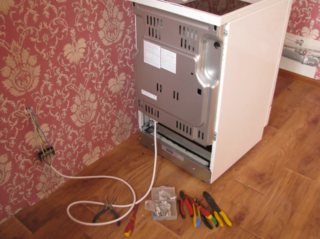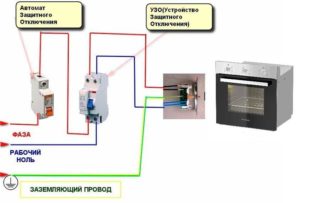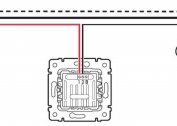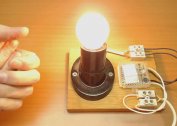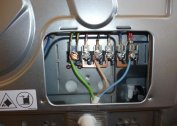Before you purchase an oven for personal needs, you will need to understand the features of its installation at the installation site. Another important issue is the connection of the oven to the mains, which can be done independently. It is recommended that you start preparing for installation by familiarizing yourself with the designs of this model of household appliances.
Types of Ovens
The correct connection of the electric oven is possible if the user has figured out the type of model purchased in advance. It is often sold complete with a hob, and sometimes separately. On this basis, products are divided into dependent and independent samples. According to the instructions, the first of them should be connected to a power source together with the panel, which significantly complicates the upcoming work. As a rule, these two products are located side by side and have a common control panel.
Between themselves, the devices are connected by a separate cable, ensuring their joint switching during operation.
Independent ovens are completely autonomous devices, the connection of which to the electric power source is not conditioned by anything. In this regard, the installation area within the kitchen can be chosen at your discretion, which should be attributed to the advantages of models without a stove.
Seat selection
 Before installing an electric oven, you will need to carry out a number of preparatory operations.
Before installing an electric oven, you will need to carry out a number of preparatory operations.
- First of all, you should decide on the place where you plan to install the product. His choice depends on the requirements of building codes, as well as on the type of oven purchased (open or built-in model).
- It is necessary to choose the zone of placement of the connecting block or outlet (if available in the kit).
- You should also evaluate the possibility of installing the hood in the selected place for the cabinet.
These factors are important because they indirectly affect the order of connection to the electrical network.
Depending on the location, the length of the power cable laid to it and the installation area of the outlet with a grounding contact will be selected.
Oven power
Before connecting an electric oven with your own hands, you should know that according to the level of energy consumption, these products are divided into several classes, denoted by the letters A, B and C. In accordance with this principle of classification, all models belong to different groups in terms of efficiency. The specified breakdown is directly related to the power indicator of the oven, regardless of its size and design (whether it is a built-in model or not).
The minimum consumption is characterized by economical products belonging to the classes "A +" and "A ++" (corresponds to electric power up to 0.6 kW). The typical value for most models ranges from 1 to 4 kW. Based on these indicators, it is possible to calculate the electrical parameters of the supply line supplied to them, including the cross section of the cable conductors and the setting of the circuit breaker.
For the average consumer, this classification is interesting in terms of the speed of cooking in the oven. There is a direct connection between the power of the unit and the cooking speed. For optimal heating, experts advise choosing models with a capacity of no more than 2.5-3 kW. This ensures quick cooking at operating temperatures of about 220 degrees, sufficient for high-quality heat treatment.
Features of connecting the built-in oven to the mains
 Before connecting the oven to electricity, it is important to know that you can directly connect it to the household electrical network (through a special block). If there is a special outlet with grounding in the kit, you can connect to the line using it.
Before connecting the oven to electricity, it is important to know that you can directly connect it to the household electrical network (through a special block). If there is a special outlet with grounding in the kit, you can connect to the line using it.
For installation, you will need the circuit shown in the instructions supplied with the product. In it, all contacts are color-coded, according to which it becomes clear where the phase wire should be connected, and where - the neutral wire. Jumpers are also indicated there, allowing you to form the desired 220 or 380 volt power supply circuits.
The choice of power cable and machine
To understand how ovens are connected to a 220V outlet, you first need to deal with the issue of connecting power to it. When studying its scheme, it is important to consider the following points:
- To power the oven, you will need a separate line with an automatic machine for a rated operating current of at least 32 Amps.
- The cross section of the wires of the laid wire is selected so that it does not overheat at maximum load (at least 4 square millimeters).
- To power the oven, you need a three-wire cable with a grounding bus.
- When laying it, the requirements of the PUE are taken into account, in which the permissible distances from the building elements and other communications are indicated.
The requirements of the PUE must be followed, even if the apartment has two-wire wiring. This will allow in the future (when installing a new power supply network) not to upgrade the oven power line.
After solving issues with eyeliner, it is important to figure out how best to connect the oven - using a wall outlet or by means of a block. The choice of inclusion option depends on many factors, as well as on the preferences of the host. On the one hand, the block fixed to the wall and covered by the lid provides more reliable contact than the most powerful outlet. However, due to the simplicity of connecting the wiring and disconnecting it from the network, it clearly loses to the socket connection, in which you just need to remove the plug.
The use of the pads is justified if there is a separate machine, by which the oven is manually turned off.
Another case where you can’t do without a pad is if the purchased oven model is designed for three-phase power. This option is more suitable for owners of private houses in which it is only possible to connect a three-phase power cable through terminal contacts.
Testing
Before finally installing the oven in the workplace, it is recommended to test it for operability. To do this, turn on the machine supplying power to it and use the tester to check the voltage at the block or terminals of the outlet. The device should show a value of 220 volts or slightly more, which immediately disappears after turning off the machine. Upon completion of testing, you can safely include the oven in the work, and then try to cook something in it.
Safety operation
For the safe operation of the oven, which could be built into the kitchen furniture or placed separately, it will be necessary to protect the user from accidental contact with dangerous potential on its body. To do this, a special terminal is provided in the switching products, which has an electrical connection to the protective grounding system.
Some experts advise to include a residual current device in the power circuit, triggered by the smallest leakage currents. It makes sense to use the protection option with RCD in those cases when a two-core power cable is put into the apartment, that is, there is no reliable and full grounding in it.
